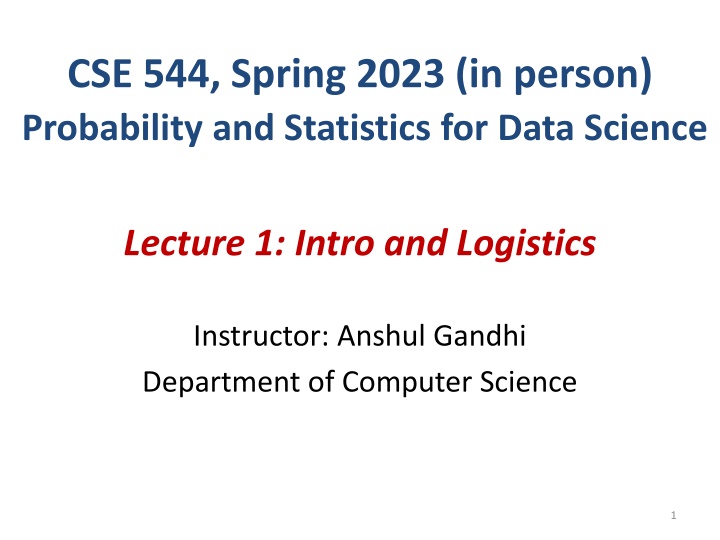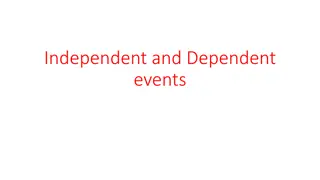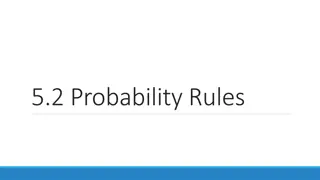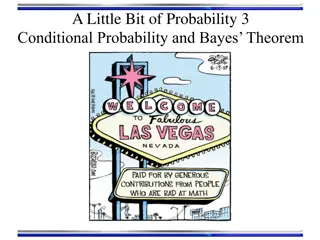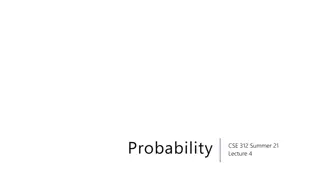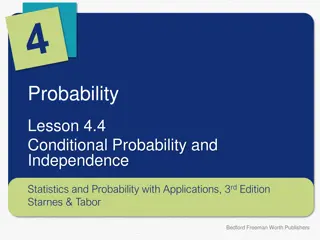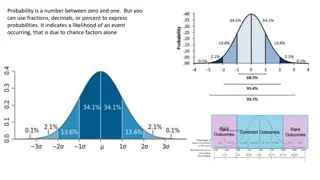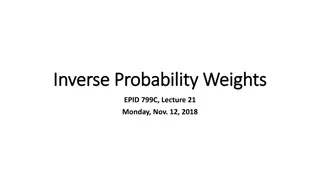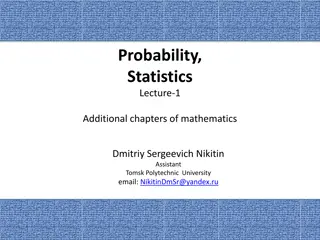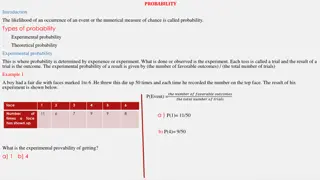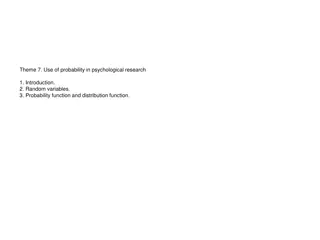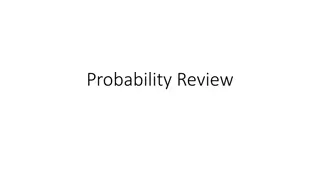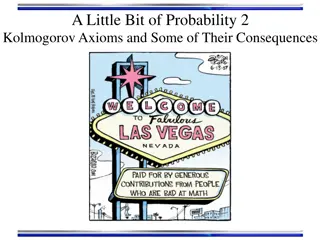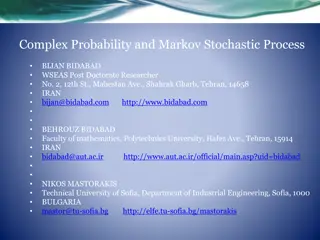Introduction to CSE 544: Probability and Statistics for Data Science
Explore CSE 544 course offering an in-person lecture on Probability and Statistics for Data Science for Spring 2023. The course covers an introduction to Data Science, Statistical Analysis, and Computer Science principles. The instructor, Anshul Gandhi, provides course logistics, contact information, and outlines the syllabus and topics to be covered. Prerequisites, required texts, and example statistics questions are also highlighted.
Download Presentation

Please find below an Image/Link to download the presentation.
The content on the website is provided AS IS for your information and personal use only. It may not be sold, licensed, or shared on other websites without obtaining consent from the author.If you encounter any issues during the download, it is possible that the publisher has removed the file from their server.
You are allowed to download the files provided on this website for personal or commercial use, subject to the condition that they are used lawfully. All files are the property of their respective owners.
The content on the website is provided AS IS for your information and personal use only. It may not be sold, licensed, or shared on other websites without obtaining consent from the author.
E N D
Presentation Transcript
CSE 544, Spring 2023 (in person) Probability and Statistics for Data Science Lecture 1: Intro and Logistics Instructor: Anshul Gandhi Department of Computer Science 1
CSE 544 Probability and Statistics for Data Science What is Data Science? Analysis of data (using several tools/techniques) Statistics/Data Analysis + CS 2
CSE 544 Probability and Statistics for Data Science Who is a Data Scientist Statistics/Data Analysis + CS Someone who is better at stats than the average CS person and someone who is better at CS than an average statistician. 3
Contact Info: Anshul Gandhi 347, New CS building anshul@cs.stonybrook.edu anshul.gandhi@stonybrook.edu PLEASE USE PIAZZA FOR ALL COMMUNICATION (more on this later) 4
Outline 1. Logistics Course info Lectures Office hours Course webpage + resources 2. Grading 3. Syllabus Tentative schedule 5
Course Info Probability theory Probability review (basics, conditional prob, Bayes theorem) Random variables (mean, variance, Geometric, Normal) Stochastic processes (Markov chains, ) Statistical inference Non-parametric inference (empirical distribution, bootstrap, sample mean, bias, confidence intervals) Parametric inference (method of moments, max. likelihood) Hypothesis testing (truth table, various tests, p-values) DS techniques Bayesian inference (Bayesian reasoning, conjugate priors) Regression analysis (linear regression, time series analysis) 6
Course Info Prerequisites: Probability and Statistics Will greatly help! Basic CS + programming background We will use Python This is NOT a systems course More of a theory + algorithms course 7
Course Info Required and recommended texts: Software: Available from DoIT 8
Example 1: Simple stats X is a collection of 99 integers (positive and negative) Mean(X) > 0 How many elements of X are > 0? Same question but now Median(X) > 0? 9
Lectures Tu Th: 9:45 11:05am Engineering 145 5-min break at the halfway point Live slides + annotations Slides on website after class No recordings (more on that later) Occasionally some programming (Python) Posted on website after class May have cancellations due to weather or unavailability Will post asap on piazza or via email 10
Lectures Interactive (please): useful checkpoints, questions Plan to take notes somewhere (book, tablet) Attendance is not mandatory but strongly encouraged All off-class communication (changes in deadlines, class cancelations, etc.) will be via piazza Please sign-up and change communication mode to real-time 11
Lectures Caveats: Large class, need to engage everyone In-class doubts and piazza iPad + pencil: sometimes slow 12
Office hours (from today) Tuesday 11am-12pm NCS 347 Friday 10am-11am Zoom TA and TA OH: TBD Will have a 1-hour TA OH every week, for assignment help Piazza for assignment queries (do not give away answers) 13
Example 2: Correlation v/s Causation Q1: Are A and B correlated? A B 14
Example 2: Correlation v/s Causation Q2: Which of the following is true (i) A causes B (ii) B causes A (iii) Either (i) or (ii) (iv) None of the above A B 15
Example 2: Correlation v/s Causation Q2: Which of the following is true (i) A causes B (ii) B causes A (iii) Either (i) or (ii) (iv) None of the above A B 16
Example 3: Correlation v/s Causation BLUE: # daily covid cases in US RED: amazon reviews claiming no scent for Yankee candles 2021 18
Course webpage www.cs.stonybrook.edu/~cse544 (will redirect) Please bookmark this page This is your best resource! Will be regularly updated Lecture slides Assignment and exam dates Assignment data files Readings Python scripts discussed in class 19
Course webpage https://www3.cs.stonybrook.edu/~cse544 20
Other resources Piazza (link on website) Primary mode of communication, please sign up! Helpful for posting lecture or assignment doubts TAs will respond in a timely manner Do NOT wait till the last moment Announcements, class cancelations, etc. Brightspace for assignments, solutions, grades Assignment submission also via Brightspace Zip all files (pdf of solution, py files, graphs, etc.) 21
Example 3: Inspection Paradox Students at BSU complain about large class sizes. In an unbiased sample poll of students, the average reported class size was far beyond 100. However, BSU admin swears that the average class size is less than 50. Who is lying? 10 students 10 students CSE 544, 180 students 10 students 10 students Avg class size = (180 + 10 + 10 + 10 + 10)/5 = 220/5 = 44 < 50 Reported average = (180*180 + 4*10*10)/220 = 149 > 100 22
Grading 36% assignments 56% exams (in-class mid-terms) 8% group mini-project 0% attendance Grading is on a curve 23
Grading - assignments 36% assignments 6 assignments (roughly once every 1.5 weeks) 6--7 problems per assignment 6% grade per assignment Later assignments will have more programming Qs based on lectures, but tougher on purpose Collaboration is allowed (groups of at most 4) One upload per group Only use techniques taught in class DO NOT COPY OR DISCUSS ACROSS GROUPS! If a group member is inactive, let me know asap You can change groups (check with me first) 24
Grading - assignments Submit files (scanned pdf, py files) as one archive on Brightspace Solutions can be typed or hand-written (legible) Only one group member needs to submit, mention all names Assignments due at 11:59pm on due-date Due date posted on class website and in assignment pdf Example: A1 due on Feb 8th (at 11:59pm) Brightspace will mark submission after 11:59pm on Feb 8th as LATE, will not be graded if late Please upload ahead of time, updates till 11:59pm allowed NO LATE SUBMISSIONS, NO EXCEPTIONS Not all questions will be addressable on release date 25
Grading - exams 56% exams Mid-terms 1 and 2 23% mid-term 1 (probs & stats), mid-March 33% mid-term 2 (inference), early May Non-overlapping In-class exams (~75mins) Easier than assignments, on-par with in-lecture questions Entirely based on material covered in class Closed-notes, closed-book (index card allowed) No programming questions No collaborations, obviously Will release practice mid-term exam a week prior 26
Grading group mini-project 8% group mini-project Basically, assignment 7, due at end of semester Data analysis project Group size of max 4 Same as assignment group (can change if needed) Mostly programming 2nd half of the semester Will discuss details as we go along 27
Grading attendance 0% Attending class will be beneficial! Exam questions centered around lecture material Useful hints/questions posed in lectures Practice questions in class will aid self-evaluation Lectures not recorded to encourage attendance, though slides will be posted on website by end-of-day 28
Grading - recap 36% assignments (6 assignments, in groups of max 4) 56% exams (in-class exams) 8% group mini-project 0% attendance Grading is on a curve Will provide mid-sem grades (after M1) For self-evaluation purposes only 29
Syllabus and Timeline Probability Theory (7--8 lectures, 2 assignments) Probability review (events, computing probability, conditional prob., Bayes thm.) Random variables (Geometric, Exponential, Normal, expectation, moments, etc.) Probability inequalities (Weak Law of Large Numbers, Central Limit thm., etc.) Markov chains (stochastic processes, balance equations, etc.) MID-TERM 1 (Early March, mostly March 9th) Statistical Inference (~14 lectures, 3 assignments) Non-parametric inference (empirical PDF, bootstrap, bias, plug-in estimator) Confidence intervals (percentiles, Normal-based CIs) Parametric inference (method of moments, max likelihood estimator) Hypothesis testing (Wald s test, t-test, KS test, p-values, permutation test) Bayesian inference (Bayesian reasoning, inference, etc.) Data Science Models (~3 lectures, 1 assignment) Regression (simple LR, multiple LR, non-linear regression) Time series analysis (moving average, EWMA, AR, ARMA, ARIMA) MID-TERM 2 (Early May, mostly May 4th) 30 MINI-PROJECT (mid-May)
Key Takeaways Very useful course for data scientist or quantitative analyst positions or ML/DS researchers Math-heavy course Exams have high weightage 31
Syllabus www.cs.stonybrook.edu/~cse544 32
Next class Probability review - 1 Basics: sample space, outcomes, probability Events: mutually exclusive, independent Calculating probability: sets, counting, tree diagram 33
Questions?? 34
